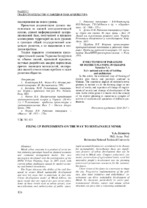| dc.contributor.author | Sysoyeva, V. А. | en |
| dc.coverage.spatial | Минск | ru |
| dc.date.accessioned | 2017-05-30T12:12:27Z | |
| dc.date.available | 2017-05-30T12:12:27Z | |
| dc.date.issued | 2017 | |
| dc.identifier.citation | Sysoyeva, V. А. Fixing up impediments on the way to sustainable Minsk = Устраняя препятствия на пути к устойчивому Минску / V. А. Sysoyeva // Архитектура : сборник научных трудов. – 2017. – Вып. 10. – С. 126-135. | en |
| dc.identifier.uri | https://rep.bntu.by/handle/data/30262 | |
| dc.description.abstract | Minsk urban structure is a product of soviet urban planning paradigm based on planned economy and command management model. The new masterplan developed with the participation of the BNTU Urban Planning Dept. in 2015 deals with current urban challenges caused by market economy and limited investments. The Paper discusses the ability of the said document to assure Minsk sustainable development and next key steps that to undertake in that aim. Urban development model of Minsk follows the main trends that are typical for post-soviet cities. Some of these trends such as urban sprawl, commercialization and authorization of public space, rapid automobilization are considered to be threats for sustainability. Nevertheless there are significant features of urban development that can be observed in Minsk only. Compact polycentric city model, preservation of agricultural lands, weak but noticeable people’s involvement into the planning process are prosperous resources for the sustainable future. Clear vision of the future is a necessity to shape the city. Progressive implementation of the policies, plus local initiatives and stakeholders’ involvement can drive sustainable development of Minsk. Its character, particularly its soviet past, transnational identity, nature and unique urban structure can grow into a welcoming community. | en |
| dc.language.iso | en_US | en |
| dc.publisher | БНТУ | ru |
| dc.title | Fixing up impediments on the way to sustainable Minsk | en |
| dc.title.alternative | Устраняя препятствия на пути к устойчивому Минску | ru |
| dc.type | Article | ru |
| local.description.annotation | Пространственная организация Минска является продуктом советской парадигмы планирования, основанной на плановой экономике и командной административной модели. Корректура генерального плана города, разработанная с участием научных специалистов кафедры «Градостроительство» БНТУ, нацелена на совершенствование Минска с учетом современных требований в условиях рыночной экономики и ограниченных инвестиций. В статье рассматривается проблема обеспечения устойчивого развития Минска, насколько она решается в новом генеральном плане и какие дополнительные шаги требуется предпринять для устранения препятствий на пути к достижению поставленных целей. Градостроительное развитие Минска во многом соответствует тенденциям, характерным для постсоветских городов: разрастание городских территорий, коммерциализация общественных пространств, рост автомобилизации считаются угрозами для устойчивого развития города. Минск имеет ряд планировочных особенностей: компактная полицентричная модель, сохранение сельскохозяйственных земель в городской черте, что наряду с высоким социальным потенциалом и уникальной национальной идентичностью города является потенциалом для обеспечения устойчивого развития Минска в будущем. | ru |

